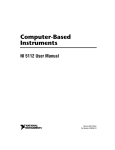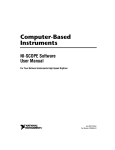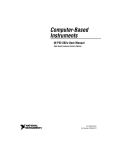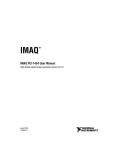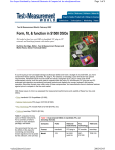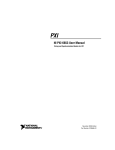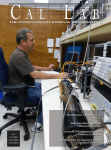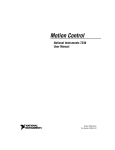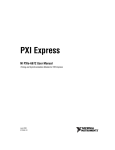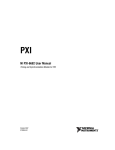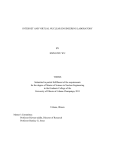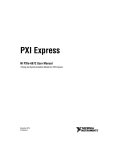Download NI PCI-5911 User Manual
Transcript
Modular Instrumentation NI PCI-5911 User Manual High-Speed Digitizer with Flex ADC ™ NI PCI-5911 User Manual March 2003 Edition Part Number 322150E-01 Support Worldwide Technical Support and Product Information ni.com National Instruments Corporate Headquarters 11500 North Mopac Expressway Austin, Texas 78759-3504 USA Tel: 512 683 0100 Worldwide Offices Australia 02 612 9672 8846, Austria 43 0 662 45 79 90 0, Belgium 32 0 2 757 00 20, Brazil 55 11 3262 3599, Canada (Calgary) 403 274 9391, Canada (Montreal) 514 288 5722, Canada (Ottawa) 613 233 5949, Canada (Québec) 514 694 8521, Canada (Toronto) 905 785 0085, Canada (Vancouver) 514 685 7530, China 86 21 6555 7838, Czech Republic 420 2 2423 5774, Denmark 45 45 76 26 00, Finland 385 0 9 725 725 11, France 33 0 1 48 14 24 24, Germany 49 0 89 741 31 30, Greece 30 2 10 42 96 427, India 91 80 51190000, Israel 972 0 3 6393737, Italy 39 02 413091, Japan 81 3 5472 2970, Korea 82 02 3451 3400, Malaysia 603 9131 0918, Mexico 001 800 010 0793, Netherlands 31 0 348 433 466, New Zealand 64 09 914 0488, Norway 47 0 32 27 73 00, Poland 48 0 22 3390 150, Portugal 351 210 311 210, Russia 7 095 238 7139, Singapore 65 6226 5886, Slovenia 386 3 425 4200, South Africa 27 0 11 805 8197, Spain 34 91 640 0085, Sweden 46 0 8 587 895 00, Switzerland 41 56 200 51 51, Taiwan 886 2 2528 7227, Thailand 662 992 7519, United Kingdom 44 0 1635 523545 For further support information, refer to the Technical Support and Professional Services appendix. To comment on the documentation, send email to [email protected]. © 1998–2003 National Instruments Corporation. All rights reserved. Important Information Warranty The NI 5911 is warranted against defects in materials and workmanship for a period of one year from the date of shipment, as evidenced by receipts or other documentation. National Instruments will, at its option, repair or replace equipment that proves to be defective during the warranty period. This warranty includes parts and labor. The media on which you receive National Instruments software are warranted not to fail to execute programming instructions, due to defects in materials and workmanship, for a period of 90 days from date of shipment, as evidenced by receipts or other documentation. National Instruments will, at its option, repair or replace software media that do not execute programming instructions if National Instruments receives notice of such defects during the warranty period. National Instruments does not warrant that the operation of the software shall be uninterrupted or error free. A Return Material Authorization (RMA) number must be obtained from the factory and clearly marked on the outside of the package before any equipment will be accepted for warranty work. National Instruments will pay the shipping costs of returning to the owner parts which are covered by warranty. National Instruments believes that the information in this document is accurate. The document has been carefully reviewed for technical accuracy. In the event that technical or typographical errors exist, National Instruments reserves the right to make changes to subsequent editions of this document without prior notice to holders of this edition. The reader should consult National Instruments if errors are suspected. In no event shall National Instruments be liable for any damages arising out of or related to this document or the information contained in it. EXCEPT AS SPECIFIED HEREIN, NATIONAL INSTRUMENTS MAKES NO WARRANTIES, EXPRESS OR IMPLIED, AND SPECIFICALLY DISCLAIMS ANY WARRANTY OF MERCHANTABILITY OR FITNESS FOR A PARTICULAR PURPOSE. CUSTOMER’S RIGHT TO RECOVER DAMAGES CAUSED BY FAULT OR NEGLIGENCE ON THE PART OF NATIONAL INSTRUMENTS SHALL BE LIMITED TO THE AMOUNT THERETOFORE PAID BY THE CUSTOMER. NATIONAL INSTRUMENTS WILL NOT BE LIABLE FOR DAMAGES RESULTING FROM LOSS OF DATA, PROFITS, USE OF PRODUCTS, OR INCIDENTAL OR CONSEQUENTIAL DAMAGES, EVEN IF ADVISED OF THE POSSIBILITY THEREOF. This limitation of the liability of National Instruments will apply regardless of the form of action, whether in contract or tort, including negligence. Any action against National Instruments must be brought within one year after the cause of action accrues. National Instruments shall not be liable for any delay in performance due to causes beyond its reasonable control. The warranty provided herein does not cover damages, defects, malfunctions, or service failures caused by owner’s failure to follow the National Instruments installation, operation, or maintenance instructions; owner’s modification of the product; owner’s abuse, misuse, or negligent acts; and power failure or surges, fire, flood, accident, actions of third parties, or other events outside reasonable control. Copyright Under the copyright laws, this publication may not be reproduced or transmitted in any form, electronic or mechanical, including photocopying, recording, storing in an information retrieval system, or translating, in whole or in part, without the prior written consent of National Instruments Corporation. Trademarks CVI™, DAQPad™, Flex ADC™, LabVIEW™, National Instruments™, NI™, ni.com™, NI-DAQ™, RTSI™, and SCXI™ are trademarks of National Instruments Corporation. Product and company names mentioned herein are trademarks or trade names of their respective companies. Patents For patents covering National Instruments products, refer to the appropriate location: Help»Patents in your software, the patents.txt file on your CD, or ni.com/patents. WARNING REGARDING USE OF NATIONAL INSTRUMENTS PRODUCTS (1) NATIONAL INSTRUMENTS PRODUCTS ARE NOT DESIGNED WITH COMPONENTS AND TESTING FOR A LEVEL OF RELIABILITY SUITABLE FOR USE IN OR IN CONNECTION WITH SURGICAL IMPLANTS OR AS CRITICAL COMPONENTS IN ANY LIFE SUPPORT SYSTEMS WHOSE FAILURE TO PERFORM CAN REASONABLY BE EXPECTED TO CAUSE SIGNIFICANT INJURY TO A HUMAN. (2) IN ANY APPLICATION, INCLUDING THE ABOVE, RELIABILITY OF OPERATION OF THE SOFTWARE PRODUCTS CAN BE IMPAIRED BY ADVERSE FACTORS, INCLUDING BUT NOT LIMITED TO FLUCTUATIONS IN ELECTRICAL POWER SUPPLY, COMPUTER HARDWARE MALFUNCTIONS, COMPUTER OPERATING SYSTEM SOFTWARE FITNESS, FITNESS OF COMPILERS AND DEVELOPMENT SOFTWARE USED TO DEVELOP AN APPLICATION, INSTALLATION ERRORS, SOFTWARE AND HARDWARE COMPATIBILITY PROBLEMS, MALFUNCTIONS OR FAILURES OF ELECTRONIC MONITORING OR CONTROL DEVICES, TRANSIENT FAILURES OF ELECTRONIC SYSTEMS (HARDWARE AND/OR SOFTWARE), UNANTICIPATED USES OR MISUSES, OR ERRORS ON THE PART OF THE USER OR APPLICATIONS DESIGNER (ADVERSE FACTORS SUCH AS THESE ARE HEREAFTER COLLECTIVELY TERMED “SYSTEM FAILURES”). ANY APPLICATION WHERE A SYSTEM FAILURE WOULD CREATE A RISK OF HARM TO PROPERTY OR PERSONS (INCLUDING THE RISK OF BODILY INJURY AND DEATH) SHOULD NOT BE RELIANT SOLELY UPON ONE FORM OF ELECTRONIC SYSTEM DUE TO THE RISK OF SYSTEM FAILURE. TO AVOID DAMAGE, INJURY, OR DEATH, THE USER OR APPLICATION DESIGNER MUST TAKE REASONABLY PRUDENT STEPS TO PROTECT AGAINST SYSTEM FAILURES, INCLUDING BUT NOT LIMITED TO BACK-UP OR SHUT DOWN MECHANISMS. BECAUSE EACH END-USER SYSTEM IS CUSTOMIZED AND DIFFERS FROM NATIONAL INSTRUMENTS' TESTING PLATFORMS AND BECAUSE A USER OR APPLICATION DESIGNER MAY USE NATIONAL INSTRUMENTS PRODUCTS IN COMBINATION WITH OTHER PRODUCTS IN A MANNER NOT EVALUATED OR CONTEMPLATED BY NATIONAL INSTRUMENTS, THE USER OR APPLICATION DESIGNER IS ULTIMATELY RESPONSIBLE FOR VERIFYING AND VALIDATING THE SUITABILITY OF NATIONAL INSTRUMENTS PRODUCTS WHENEVER NATIONAL INSTRUMENTS PRODUCTS ARE INCORPORATED IN A SYSTEM OR APPLICATION, INCLUDING, WITHOUT LIMITATION, THE APPROPRIATE DESIGN, PROCESS AND SAFETY LEVEL OF SUCH SYSTEM OR APPLICATION. Compliance FCC/Canada Radio Frequency Interference Compliance Determining FCC Class The Federal Communications Commission (FCC) has rules to protect wireless communications from interference. The FCC places digital electronics into two classes. These classes are known as Class A (for use in industrial-commercial locations only) or Class B (for use in residential or commercial locations). All National Instruments (NI) products are FCC Class A products. Depending on where it is operated, this Class A product could be subject to restrictions in the FCC rules. (In Canada, the Department of Communications (DOC), of Industry Canada, regulates wireless interference in much the same way.) Digital electronics emit weak signals during normal operation that can affect radio, television, or other wireless products. All Class A products display a simple warning statement of one paragraph in length regarding interference and undesired operation. The FCC rules have restrictions regarding the locations where FCC Class A products can be operated. Consult the FCC Web site at www.fcc.gov for more information. FCC/DOC Warnings This equipment generates and uses radio frequency energy and, if not installed and used in strict accordance with the instructions in this manual and the CE marking Declaration of Conformity*, may cause interference to radio and television reception. Classification requirements are the same for the Federal Communications Commission (FCC) and the Canadian Department of Communications (DOC). Changes or modifications not expressly approved by NI could void the user’s authority to operate the equipment under the FCC Rules. Class A Federal Communications Commission This equipment has been tested and found to comply with the limits for a Class A digital device, pursuant to part 15 of the FCC Rules. These limits are designed to provide reasonable protection against harmful interference when the equipment is operated in a commercial environment. This equipment generates, uses, and can radiate radio frequency energy and, if not installed and used in accordance with the instruction manual, may cause harmful interference to radio communications. Operation of this equipment in a residential area is likely to cause harmful interference in which case the user is required to correct the interference at their own expense. Canadian Department of Communications This Class A digital apparatus meets all requirements of the Canadian Interference-Causing Equipment Regulations. Cet appareil numérique de la classe A respecte toutes les exigences du Règlement sur le matériel brouilleur du Canada. Compliance to EU Directives Readers in the European Union (EU) must refer to the manufacturer’s Declaration of Conformity (DoC) for information* pertaining to the CE marking compliance scheme. The manufacturer includes a DoC for most hardware products except for those bought from OEMs. In addition, DoCs are usually not provided if compliance is not required, for example electrically benign apparatus or cables. To obtain the DoC for this product, click Declaration of Conformity at ni.com/hardref.nsf/. This Web site lists the DoCs by product family. Select the appropriate product family, followed by your product, and a link to the DoC appears in Adobe Acrobat format. Click the Acrobat icon to download or read the DoC. * The CE marking Declaration of Conformity contains important supplementary information and instructions for the user or installer. Contents About This Manual Conventions ...................................................................................................................vii Related Documentation..................................................................................................viii Safety Information .........................................................................................................viii Chapter 1 Introduction Installing the NI 5911 ....................................................................................................1-1 Connecting Signals ........................................................................................................1-1 Acquiring Data with the NI 5911 ..................................................................................1-3 Programmatically Controlling the NI 5911.....................................................1-3 Interactively Controlling the NI 5911 with the Scope Soft Front Panel .........1-4 Chapter 2 Hardware Overview Differential Programmable Gain Input Amplifier (PGIA) ............................................2-1 Differential Input .............................................................................................2-1 Grounding Considerations ................................................................2-2 Input Ranges....................................................................................................2-3 Input Impedance ..............................................................................................2-3 Input Bias ..........................................................................................2-4 Input Protection ...............................................................................................2-4 AC Coupling....................................................................................................2-4 Conventional and Flexible Resolution Modes...............................................................2-5 Conventional Mode .........................................................................................2-5 Sampling Methods...........................................................................................2-5 Flexible Resolution Mode ...............................................................................2-6 How Flexible Resolution Works.......................................................2-6 Calibration .....................................................................................................................2-7 Self-Calibrating the NI 5911 ...........................................................................2-7 When Self-Calibration Is Needed....................................................................2-7 What Self-Calibration Does ............................................................................2-7 Why Warnings Occur During Acquisition........................................2-8 External Calibration.........................................................................................2-8 Triggering and Arming ..................................................................................................2-8 Analog Trigger Circuit ....................................................................................2-9 Trigger Holdoff ...............................................................................................2-10 © National Instruments Corporation v NI PCI-5911 User Manual Contents Memory ......................................................................................................................... 2-10 Triggering and Memory Usage ....................................................................... 2-10 Multi-Record Acquisitions ............................................................................................ 2-11 RTSI Bus and Clock PFI ............................................................................................... 2-11 PFI Lines ......................................................................................................... 2-11 PFI Lines as Inputs ........................................................................... 2-12 PFI Lines as Outputs......................................................................... 2-12 Synchronization .............................................................................................. 2-12 Appendix A Specifications Appendix B Technical Support and Professional Services Glossary Index NI PCI-5911 User Manual vi ni.com About This Manual The NI 5911 User Manual provides information on installing, connecting signals to, and acquiring data from your NI 5911 high-speed digitizer. This manual includes an overview of the NI 5911 and explains the operation of each functional unit of the NI 5911. Conventions The following conventions appear in this manual: <> Angle brackets that contain numbers separated by an ellipsis represent a range of values associated with a bit or signal name—for example, DIO<3..0>. » The » symbol leads you through nested menu items and dialog box options to a final action. The sequence File»Page Setup»Options directs you to pull down the File menu, select the Page Setup item, and select Options from the last dialog box. This icon denotes a note, which alerts you to important information. This icon denotes a caution, which advises you of precautions to take to avoid injury, data loss, or a system crash. bold Bold text denotes items that you must select or click in the software, such as menu items and dialog box options. Bold text also denotes parameter names. italic Italic text denotes variables, emphasis, a cross reference, or an introduction to a key concept. This font also denotes text that is a placeholder for a word or value that you must supply. monospace Text in this font denotes text or characters that you should enter from the keyboard, sections of code, programming examples, and syntax examples. This font is also used for the proper names of disk drives, paths, directories, programs, subprograms, subroutines, device names, functions, operations, variables, filenames and extensions, and code excerpts. © National Instruments Corporation vii NI PCI-5911 User Manual About This Manual Related Documentation The following documents contain information that you might find helpful as you read this manual: • Where to Start with Your NI Digitizer • NI-SCOPE Software User Manual • NI-SCOPE Instrument Driver Quick Reference Guide You can download these documents from ni.com/manuals. Safety Information This section contains important safety information that you must follow when installing and using the device. Do not operate the device in a manner not specified in this document. Misuse of the device can result in a hazard. You can compromise the safety protection built into the device if the device is damaged in any way. If the device is damaged, return it to National Instruments (NI) for repair. Do not substitute parts or modify the device except as described in this document. Use the device only with the chassis, devices, accessories, and cables specified in the installation instructions. You must have all covers and filler panels installed during operation of the device. Do not operate the device in an explosive atmosphere or where there may be flammable gases or fumes. If you must operate the device in such an environment, it must be in a suitably rated enclosure. If you need to clean the device, use a soft, nonmetallic brush. Make sure that the device is completely dry and free from contaminants before returning it to service. Operate the device only at or below Pollution Degree 2. Pollution is foreign matter in a solid, liquid, or gaseous state that can reduce dielectric strength or surface resistivity. The following is a description of pollution degrees: NI PCI-5911 User Manual • Pollution Degree 1 means no pollution or only dry, nonconductive pollution occurs. The pollution has no influence. • Pollution Degree 2 means that only nonconductive pollution occurs in most cases. Occasionally, however, a temporary conductivity caused by condensation must be expected. viii ni.com About This Manual • Pollution Degree 3 means that conductive pollution occurs, or dry, nonconductive pollution occurs that becomes conductive due to condensation. You must insulate signal connections for the maximum voltage for which the device is rated. Do not exceed the maximum ratings for the device. Do not install wiring while the device is live with electrical signals. Do not remove or add connector blocks when power is connected to the system. Avoid contact between your body and the connector block signal when hot swapping devices. Remove power from signal lines before connecting them to or disconnecting them from the device. Operate the device at or below the installation category1 marked on the hardware label. Measurement circuits are subjected to working voltages2 and transient stresses (overvoltage) from the circuit to which they are connected during measurement or test. Installation categories establish standard impulse withstand voltage levels that commonly occur in electrical distribution systems. The following is a description of installation categories: 1 2 3 • Installation Category I is for measurements performed on circuits not directly connected to the electrical distribution system referred to as MAINS3 voltage. This category is for measurements of voltages from specially protected secondary circuits. Such voltage measurements include signal levels, special equipment, limited-energy parts of equipment, circuits powered by regulated low-voltage sources, and electronics. • Installation Category II is for measurements performed on circuits directly connected to the electrical distribution system. This category refers to local-level electrical distribution, such as that provided by a standard wall outlet (for example, 115 AC voltage for U.S. or 230 AC voltage for Europe). Examples of Installation Category II are measurements performed on household appliances, portable tools, and similar devices. • Installation Category III is for measurements performed in the building installation at the distribution level. This category refers to measurements on hard-wired equipment such as equipment in fixed installations, distribution boards, and circuit breakers. Other examples are wiring, including cables, bus bars, junction boxes, switches, socket Installation categories, also referred to as measurement categories, are defined in electrical safety standard IEC 61010-1. Working voltage is the highest rms value of an AC or DC voltage that can occur across any particular insulation. MAINS is defined as a hazardous live electrical supply system that powers equipment. Suitably rated measuring circuits may be connected to the MAINS for measuring purposes. © National Instruments Corporation ix NI PCI-5911 User Manual About This Manual outlets in the fixed installation, and stationary motors with permanent connections to fixed installations. • NI PCI-5911 User Manual Installation Category IV is for measurements performed at the primary electrical supply installation (<1,000 V). Examples include electricity meters and measurements on primary overcurrent protection devices and on ripple control units. x ni.com 1 Introduction Thank you for buying an NI PCI-5911 digitizer, featuring the Flex ADC for variable speed and resolution. This chapter contains information on installing, connecting signals to, and acquiring data from the NI 5911 Installing the NI 5911 Installation involves the following main steps: 1. Install the NI-SCOPE driver software. You use this driver to write programs to control the NI 5911 in different application development environments (ADEs). Installing NI-SCOPE also allows you to interactively control the NI 5911 with the Scope Soft Front Panel. 2. Install the NI 5911. For step-by-step instructions for installing both NI-SCOPE and the NI 5911, refer to the Where to Start with Your NI Digitizer document. For multiple-device considerations, refer to the Operating Environment section of Appendix A, Specifications. Connecting Signals Figure 1-1 shows the front panel of the NI 5911. The front panel contains three connectors—a BNC connector, an SMB connector, and a 9-pin mini-circular DIN connector. Figure 1-2 shows the 9-pin mini-circular DIN connector. The BNC connector is for attaching the analog input signal you want to measure. The BNC connector is analog input channel 0. To minimize noise, do not allow the shell of the BNC cable to touch or lie near the metal of the computer chassis. The SMB connector is used for external triggers and for generating a probe compensation signal. The SMB connector is labeled PFI 1. The DIN connector provides access to an additional external trigger line. The DIN connector can be used to access PFI 2. © National Instruments Corporation 1-1 NI PCI-5911 User Manual Chapter 1 Introduction The +5 V signal is fused at 1.1 A. However, NI recommends limiting the current from this pin to 30 mA. The fuse is self-resetting. Note CH 0 PFI 1 PFI 2 (DIN) Figure 1-1. NI 5911 Connectors NI PCI-5911 User Manual 1-2 ni.com Chapter 1 9 8 6 1 2 3 +5 V (Fused) GND Reserved 4 5 6 7 5 4 2 1 Reserved Reserved PFI 2 Introduction 3 7 8 9 Reserved Reserved Reserved Figure 1-2. 9-Pin Mini-Circular DIN Connector Acquiring Data with the NI 5911 You can acquire data either programmatically—by writing an application for the NI 5911—or interactively with the Scope Soft Front Panel. Programmatically Controlling the NI 5911 To help you get started programming the NI 5911, NI-SCOPE includes examples that you can use or modify. You can find examples for the following ADEs in these locations: • LabVIEW—Go to Program Files\National Instruments\ LabVIEW\Examples\Instr\niScopeExamples\. • LabWindows™/CVI™, C, and Visual Basic with Windows 2000/NT—Go to vxipnp\winnt\Niscope\Examples\. • LabWindows/CVI, C, and Visual Basic with Windows 98/95—Go to vxipnp\win95\Niscope\Examples\c\. For information on using NI-SCOPE to programmatically control your digitizer, refer to the NI-SCOPE Software User Manual. Another resource is the NI-SCOPE Instrument Driver Quick Reference Guide, which contains abbreviated information on the most commonly used functions and LabVIEW VIs. For more detailed function reference help, refer to the © National Instruments Corporation 1-3 NI PCI-5911 User Manual Chapter 1 Introduction NI-SCOPE Function Reference Help, located at Start»Programs» National Instruments»NI-SCOPE. For more detailed VI help, use LabVIEW context-sensitive help (Help»Show Context Help) or the NI-SCOPE VI Reference Help, located at Start»Programs»National Instruments»NI-SCOPE. Interactively Controlling the NI 5911 with the Scope Soft Front Panel The Scope Soft Front Panel allows you to interactively control the NI 5911 as you would a desktop oscilloscope. To launch the Scope Soft Front Panel, select Start»Programs»National Instruments»NI-SCOPE» NI-SCOPE Soft Front Panel. Refer to the Scope Soft Front Panel Help for instructions on configuring the Scope Soft Front Panel for your specific application. Press <F1> while the Scope Soft Front Panel is running to access the Scope Soft Front Panel Help. Note NI PCI-5911 User Manual 1-4 ni.com 2 Hardware Overview This chapter includes an overview of the NI 5911, explains the operation of each functional unit making up the NI 5911, and describes the signal connections. Figure 2-1 shows a block diagram of the NI 5911. Analog Input Connector AC/DC Coupling Protect/ Calibration Mux PGIA A/D Converter 100 MHz, 8-Bit Noise Shaper Calibration Generator Timing I/O, Memory Control Digital I/O Connector Digital Signal Processor Capture Memory Reference Clock Data Figure 2-1. NI 5911 Block Diagram Differential Programmable Gain Input Amplifier (PGIA) The analog input of the NI 5911 is equipped with a differential programmable gain input amplifier. The PGIA accurately interfaces to and scales the signal presented to the ADC regardless of source impedance, source amplitude, DC biasing, or common-mode noise voltages. Differential Input When measuring high dynamic range signals, ground noise is often a problem. The PGIA of the NI 5911 allows you to make noise-free signal measurements. The PGIA differential amplifier efficiently rejects any noise present on the ground signal. Internal to the PGIA, the signal © National Instruments Corporation 2-1 NI PCI-5911 User Manual Chapter 2 Hardware Overview presented at the negative input is subtracted from the signal presented at the positive input. As shown in Figure 2-2, this subtraction removes ground noise from the signal. The inner conductor of the BNC is V+. The outer shell is V–. Input Signal V+ V– + Vout PGIA – Ground Noise Figure 2-2. Signal Noise-Free Measurements Grounding Considerations The path for the positive signal has been optimized for speed and linearity. You should always apply signals to the positive input and ground to the negative input. Reversing the inputs results in higher distortion and lower bandwidth. The negative input of the amplifier is grounded to PC ground through a 10 kΩ resistor. The PGIA is therefore referenced to ground, so it is not necessary to make any external ground connections. If the device you connect to the NI 5911 is already connected to ground, ground-loop noise voltages may be induced into your system. Notice that in most of these situations, the 10 kΩ resistance to PC ground is normally much higher than the cable impedances you use. As a result, most of the noise voltage occurs at the negative input of the PGIA where it is rejected, rather than in the positive input, where it would be amplified. NI PCI-5911 User Manual 2-2 ni.com Chapter 2 Hardware Overview Input Ranges To optimize the ADC resolution, you can select different gains for the PGIA so that you can scale your input signal to match the full input range of the converter. The NI 5911 PGIA offers seven input ranges, from ±0.1 V to ±10 V, as shown in Table 2-1. Table 2-1. Input Ranges for the NI 5911 Range Input Protection Threshold ±10 V ±10 V ±5 V ±5 V ±2 V ±5 V ±1 V ±5 V ±0.5 V ±5 V ±0.2 V ±5 V ±0.1 V ±5 V If you try to acquire a signal below the set input range, the sensitive front-end components of the NI 5911 may become unstable and begin returning invalid data. To return the digitizer to a stable configuration, switch to the maximum input range setting and acquire an AC coupled or 0 V signal. Note The input stage of the NI 5911 requires a settling time that depends on which vertical range you are switching from and which vertical range you are switching to. However, allowing for a delay of 250 ms between configuring the input stage and starting the acquisition guarantees proper settling. Input Impedance The input impedance of the NI 5911 PGIA is 1 MΩ between the positive and negative input, ±2% depending on input capacitance. The output impedance of the device connected to the NI 5911 and the input impedance of the NI 5911 form an impedance divider, which attenuates the input signal according to the following formula: V s R in V m = ------------------R s + R in © National Instruments Corporation 2-3 NI PCI-5911 User Manual Chapter 2 Hardware Overview where Vm is the measured voltage, Vs is the source voltage, Rs is the external source impedance, and Rin is the input impedance. If the device you are measuring has a very large output impedance, your measurements will be affected by this impedance divider. For example, if the device has 1 MΩ output impedance, your measured signal is one-half of the actual signal value. Input Bias The inputs of the PGIA typically draw an input bias current of 1 nA at 25 °C. Attaching a device with a very high source impedance can cause an offset voltage to be added to the signal measured, according to the formula Rs × 1 nA, where Rs is the external source impedance. For example, if the device you have attached to the NI 5911 has an output impedance of 10 kΩ, typically the offset voltage is 10 µV (10 kΩ × 1 nA). Input Protection The NI 5911 features input-protection circuits that protect both the positive and negative analog inputs from damage from AC and DC signals up to ±42 V. If the voltage at one of these inputs exceeds a threshold voltage, Vtr , the input clamps to Vtr and a resistance of 100 kΩ is inserted in the path to minimize input currents to a nonharmful level. The protection voltage, Vtr, is input range dependent, as shown in Table 2-1. AC Coupling When you measure a small AC signal on top of a large DC component, you can use AC coupling. AC coupling rejects any DC component in your signal before it enters into the PGIA. Activating AC coupling inserts a capacitor in series with the input impedance. You can select input coupling through software. When changing the coupling on the digitizer, the input stage takes a finite amount of time to settle. When switching from AC to DC coupling, the settling time is approximately 0.5 ms. When switching from DC to AC coupling, the returned data is accurate several time constants after switching to AC. The NI 5911 has a time constant value of 68 ms. The equation 1 – e–t/T, where T is the time constant, gives the percentage that the original signal has settled after time t. Generally, six time constants is enough time between switching to AC coupling and starting the acquisition NI PCI-5911 User Manual 2-4 ni.com Chapter 2 Hardware Overview to allow an 8-bit digitizer to acquire accurate data. However, the NI 5911 in flexible resolution mode is much more precise and thus requires a greater number of time constants of settling time to achieve the desired precision. Refer to Appendix A, Digitizer Basics, of the NI-SCOPE Software User Manual, for more information on input coupling. Conventional and Flexible Resolution Modes In conventional mode, the NI 5911 works as a conventional desktop oscilloscope, acquiring data at 100 MS/s with a vertical resolution of 8 bits. This mode is useful for displaying waveforms and for deriving waveform parameters such as slew rate, rise time, and settling time. Flexible resolution mode differs from conventional mode in two ways: it has higher resolution (sampling rate dependent), and the signal bandwidth is limited to provide antialiasing protection. Flexible resolution mode is useful for spectral analysis, distortion analysis, and other measurements for which high resolution is crucial. Conventional Mode The ADC converts at a constant rate of 100 MS/s, but you can choose to store only a fraction of these samples into memory at a lower rate. This lower rate allows you to store waveforms using fewer data points and decreases the burden of storing, analyzing, and displaying the waveforms. If you need faster sampling rates, you can use Random Interleaved Sampling (RIS) to effectively increase the sampling rate to 1 GS/s for repetitive waveforms. In conventional mode, all signals up to 100 MHz are passed to the ADC. You must ensure that your signal is band-limited to prevent aliasing. Aliasing and other sampling terms are described more thoroughly in the NI-SCOPE Software User Manual. Sampling Methods Two sampling methods are available in conventional mode: real-time sampling and random interleaved sampling (RIS). Using real-time sampling, you can acquire data at a rate of 100/n MS/s, where n is a number from 1 to 224. RIS sampling can be used on repetitive signals to effectively extend the sampling rate above 100 MS/s. In RIS mode, you can sample at rates of 100 × n MS/s, where n is a number from 2 to 10. © National Instruments Corporation 2-5 NI PCI-5911 User Manual Chapter 2 Hardware Overview Flexible Resolution Mode Table 2-2 shows the relationship between the available sampling rates, resolution, and the corresponding bandwidth for flexible resolution mode. Table 2-2. Available Sampling Rates and Corresponding Bandwidth in Flexible Resolution Mode Sampling Rate Resolution Bandwidth 12.5 MS/s 11 bits 3.75 MHz 5 MS/s 14 bits 2 MHz 2.5 MS/s 15.5 bits 1 MHz 1 MS/s 17.5 bits 400 kHz 500 kS/s 18 bits 200 kHz 200 kS/s 18.5 bits 80 kHz 100 kS/s 19 bits 40 kHz 50 kS/s 19.5 bits 20 kHz 20 kS/s 20.5 bits 8 kHz 10 kS/s 21 bits 4 kHz Like any other type of converter that uses noise shaping to enhance resolution, the frequency response of the converter is only flat to its maximum useful bandwidth. The NI 5911 has a bandwidth of 4 MHz. Beyond this frequency, there is a span where the converter acts resonant and where a signal is amplified before being converted. These signals are attenuated in the subsequent digital filter to prevent aliasing. However, if the applied signal contains major signal components in this frequency range, such as harmonics or noise, the converter may overload and signal data will be invalid. In this case, you receive an overload warning. You must then either select a higher input range or attenuate the signal. How Flexible Resolution Works The ADC can be sourced through a noise shaping circuit that moves quantization noise on the output of the ADC from lower frequencies to higher frequencies. A digital lowpass filter applied to the data removes all but a fraction of the original shaped quantization noise. The signal is then resampled to a lower sampling frequency and a higher resolution. Flexible resolution provides antialiasing protection due to the digital lowpass filter. NI PCI-5911 User Manual 2-6 ni.com Chapter 2 Hardware Overview Calibration The NI 5911 can be calibrated for high accuracy and resolution because of an advanced calibration scheme. There are two different types of calibration: internal, or self-calibration, and external calibration. A third option, internal restore, restores factory settings and should be used only in the event of a self-calibration failure. Self-calibration is performed using a software command that compensates for drifts caused by environmental temperature changes. You can self-calibrate the NI 5911 without any external equipment connected. External calibration requires you to connect an external precision voltage reference to the device. External calibration recalibrates the device when the specified calibration interval has expired. Refer to Appendix A, Specifications, for the calibration interval. Self-Calibrating the NI 5911 You can self-calibrate the NI 5911 with a software function or a LabVIEW VI. Refer to Chapter 3, Common Functions and Examples, of the NI-SCOPE Software User Manual, for step-by-step instructions for self-calibrating the NI 5911. When Self-Calibration Is Needed To provide the maximum accuracy independent of temperature changes, the NI 5911 contains a heater that stabilizes the temperature of the most sensitive circuitries on the board. However, the heater can accommodate for temperature changes over a fixed range of ±5 °C. When temperatures exceed this range, the heater cannot stabilize the temperature, and signal data becomes inaccurate. When the temperature range has been exceeded, you receive a warning, and you must perform an internal calibration. What Self-Calibration Does Self-calibration performs the following operations: • The heater is set to regulate over a range of temperatures centered at the current environmental temperature. The circuit components require time to stabilize at the new temperature. This temperature stabilization accounts for the majority of the calibration time. Refer to the Calibration section of Appendix A, Specifications, for more information. • Gain and offset are calibrated for each individual input range. © National Instruments Corporation 2-7 NI PCI-5911 User Manual Chapter 2 Hardware Overview • The linearity of the ADC is calibrated using an internal sine wave generator as reference. • The time-to-digital converter used for RIS measurements is calibrated. Caution Do not apply high-amplitude or high-frequency signals to the NI 5911 during self-calibration. For optimal calibration performance, disconnect the input signal from the NI 5911. Why Warnings Occur During Acquisition The NI 5911 uses a heater circuit to maintain constant temperature on the critical circuitry used in flexible resolution mode. If this circuit cannot maintain the temperature within specification, a warning is generated. This warning indicates that the temperature of the ADC is out of range and should be recalibrated with a self-calibration. During acquisition in flexible resolution mode, a warning is generated if the input to the ADC goes out of range for the converter. The fact that this condition has occurred may not be obvious from inspecting the data because of the digital filtering that takes place on the acquired data. Therefore, a warning occurs to notify you that the data includes some samples that were out of the range of the converter and may be inaccurate. External Calibration External calibration calibrates the internal reference on the NI 5911. The NI 5911 is already calibrated when it is shipped from the factory. Periodically, the NI 5911 needs external calibration to remain within the specified accuracy. For more information on calibration, contact NI, or visit ni.com/calibration. For actual intervals and accuracy, refer to the Calibration section of Appendix A, Specifications. Triggering and Arming There are several triggering methods for the NI 5911. The trigger can be an analog level that is compared to the input or any of several digital inputs. You also can call a software function to trigger the digitizer. Figure 2-3 shows the different trigger sources. When you use a digital signal, that signal must be at a high TTL level for at least 40 ns before any triggers are accepted. Note The NI 5911 does not support delayed triggering. NI PCI-5911 User Manual 2-8 ni.com Chapter 2 Analog Input High Level Gain + COMP Analog Trigger Circuit Low Level Hardware Overview ATC_OUT COMP – a. Analog Trigger Circuit Software ATC_OUT RTSI<0..6> Trigger 7 PFI 1, PFI 2 2 Arm b. Trigger and Arm Sources Figure 2-3. Trigger Sources Analog Trigger Circuit The analog trigger on the NI 5911 operates by comparing the current analog input to an onboard threshold voltage. This threshold voltage is the trigger value, and can be set within the current input range in 170 steps. Therefore, for a ±10 V input range, the trigger can be set in increments of 20 V/170 = 118 mV. A hysteresis value may also be associated with the trigger that can be set in the same size increments. The hysteresis value creates a trigger window the signal must pass through before the trigger is accepted. You can generate triggers on a rising or falling edge condition. For more information on triggering, refer to Chapter 3, Common Functions and Examples, of the NI-SCOPE Software User Manual. © National Instruments Corporation 2-9 NI PCI-5911 User Manual Chapter 2 Hardware Overview Trigger Holdoff Trigger holdoff is the minimum length of time (in seconds) from an accepted trigger to the start of the next record. In other words, when a trigger is accepted, the trigger counter is loaded with the desired holdoff time. After completing its current record, the digitizer records no data and accepts no triggers until the holdoff counter runs out. When the counter runs out, the next record begins and a trigger may be accepted. Setting a holdoff time shorter than posttrigger acquisition time has no effect, as triggers are always rejected during an acquisition. Time to acquire posttrigger samples is calculated by the following formula: (posttrigger samples)/(sample rate). Note Trigger holdoff is provided in hardware using a 32-bit counter clocked by a 25 MHz internal timebase. With this configuration, you can select a hardware holdoff value of 5 µs to 171.79 s in increments of 40 ns. For more information on trigger holdoff, refer to Chapter 3, Common Functions and Examples, of the NI-SCOPE Software User Manual. Memory The NI 5911 allocates at least 4 kB of onboard memory for each record in a single multi-record acquisition. Samples are stored in this buffer before transfer to the host computer. Thus the minimum size for a buffer in the onboard memory is approximately 4,000 8-bit conventional mode samples or 1,000 32-bit flexible resolution mode samples. Software allows you to specify buffers of less than these minimum buffer sizes because only the specified number of points is transferred from onboard memory into the memory of the host computer. The total number of samples that can be stored depends on the size of the acquisition memory module installed on the NI 5911 and the size of each acquired sample. The maximum number of records in a single multi-record acquisition is equal to the size of the memory module divided by 4 kB. Triggering and Memory Usage During the acquisition, samples are stored in a circular buffer that is continually rewritten until a trigger is received. After the trigger is received, the NI 5911 continues to acquire posttrigger samples if you have specified a posttrigger sample count. The acquired samples are placed into onboard memory. The number of posttrigger or pretrigger samples is only limited by the amount of onboard memory. NI PCI-5911 User Manual 2-10 ni.com Chapter 2 Hardware Overview Multi-Record Acquisitions After the trigger has been received and the posttrigger samples have been stored, the NI 5911 can be configured to begin another acquisition that is stored in another onboard memory record. This operation is a multi-record acquisition. To perform multi-record acquisitions, configure the NI 5911 to the number of records you want to acquire before starting the acquisition. The NI 5911 acquires an additional record each time a trigger is accepted until all the requested records are stored in memory. You may acquire up to 1,024 records if your NI 5911 is equipped with 4 MB of onboard memory, or 4,096 records with 16 MB of onboard memory. Software intervention after the initial setup is not required. Multi-record acquisitions can quickly acquire numerous triggered waveforms because they allow hardware rearming of the digitizer before the data is fetched. Therefore the dead time, or the time when the digitizer is not ready for a trigger, is extremely small. For more information on multi-record acquisitions and dead time, refer to Chapter 5, Tasks and Examples, of the NI-SCOPE Software User Manual. RTSI Bus and Clock PFI The Real-Time System Integration (RTSI) bus allows NI digitizers to synchronize timing and triggering on multiple devices. The RTSI bus has seven bidirectional trigger lines and one bidirectional clock signal. You can program any of the seven trigger lines to provide or accept a synchronous trigger signal. You can also use any of the RTSI trigger lines to provide a synchronization pulse from a master device if you are synchronizing multiple NI 5911 devices. You can use the RTSI bus clock line to provide or accept a 10 MHz reference clock to synchronize multiple NI 5911 devices. PFI Lines The NI 5911 has two digital lines that can accept a trigger, accept or generate a reference clock, or output a 1 kHz square wave. The function of each PFI line is independent. However, only one trigger source can be accepted during acquisition. © National Instruments Corporation 2-11 NI PCI-5911 User Manual Chapter 2 Hardware Overview PFI Lines as Inputs You can select PFI 1 or PFI 2 as inputs for a trigger or a reference clock. Refer to the Synchronization section for more information about the use of reference clocks in the NI 5911. PFI Lines as Outputs You can select PFI 1 or PFI 2 to output several digital signals. Reference Clock is a 10 MHz clock that is synchronous to the 100 MHz sample clock on the NI 5911. You can use the Reference Clock to synchronize to another NI 5911 configured as a slave device or to other equipment that can accept a 10 MHz reference. Frequency Output is a 1 kHz digital pulse train signal with a 50% duty cycle. The most common application of Frequency Output for the NI 5911 is to provide a signal for compensating a passive probe. Synchronization The NI 5911 uses a digital phase-locked loop to synchronize the 100 MHz sample clock to a 10 MHz reference. This reference frequency can be supplied by an internal crystal oscillator or through an external frequency input through the RTSI bus clock line or a PFI input. The NI 5911 can also output its 10 MHz reference on the RTSI bus clock line or a PFI line so that additional NI 5911 devices or other equipment can be synchronized to the same reference. While the reference clock input is sufficient to synchronize the 100 MHz sample clocks, it is also necessary to synchronize clock dividers on each NI 5911 so that internal clock divisors are synchronized on each device. These lower frequencies are important because they are used to determine trigger times and sample position. To synchronize the NI 5911 clock dividers, you must connect the digitizers with an RTSI bus cable. One of the RTSI bus triggers must be designated as a synchronization line. This line is an output from the master device and an input on the slave device. To synchronize the digitizers, a single pulse is sent from the master NI 5911 to the slaves. This pulse supplies the slave devices with a reference time to clear their clock dividers. Hardware arming cannot be used during an acquisition using multiple devices. To synchronize the triggers of multiple NI 5911 devices, one digitizer must receive a trigger as described in the Triggering and Arming section and then NI PCI-5911 User Manual 2-12 ni.com Chapter 2 Hardware Overview route that trigger over the RTSI bus to trigger the other digitizer(s). However, the trigger that is routed to the other digitizer(s) is sent synchronously to an internal 25 MHz clock. For more information about synchronization, refer to the NI-SCOPE Software User Manual. © National Instruments Corporation 2-13 NI PCI-5911 User Manual A Specifications This appendix lists the specifications of the NI 5911. These specifications are typical at 25 °C unless otherwise stated. Acquisition System Bandwidth .............................................. 100 MHz maximum; refer to Table 2-2, Available Sampling Rates and Corresponding Bandwidth in Flexible Resolution Mode Number of channels ............................... 1 Number of flexible resolution ADC....... 1 Max RIS sample rate.............................. 1 GS/s Max real-time sample rate...................... 100 MS/s Resolution Sample Rate © National Instruments Corporation Mode Effective Resolution 100/n* MS/s Conventional 8 bits 12.5 MS/s Flexible Resolution 11 bits 5 MS/s Flexible Resolution 14 bits 2.5 MS/s Flexible Resolution 15.5 bits 1 MS/s Flexible Resolution 17.5 bits 500 kS/s Flexible Resolution 18 bits 200 kS/s Flexible Resolution 18.5 bits 100 kS/s Flexible Resolution 19 bits 50 kS/s Flexible Resolution 19.5 bits A-1 NI PCI-5911 User Manual Appendix A Specifications Sample Rate Mode Effective Resolution 20 kS/s Flexible Resolution 20.5 bits 10 kS/s Flexible Resolution 21 bits * 1 ≤ n ≤ 224 in conventional mode Sample onboard memory........................4 MB or 16 MB Memory Sample Depth Sampling Frequency Mode Sample Depth (4 MB) Sample Depth (16 MB) 100/n* MS/s Conventional 4 MS 16 MS 12.5 MS/s Flexible Resolution 1 MS 4 MS 5 MS/s Flexible Resolution 1 MS 4 MS 2.5 MS/s Flexible Resolution 1 MS 4 MS 1 MS/s Flexible Resolution 1 MS 4 MS 500 kS/s Flexible Resolution 1 MS 4 MS 200 kS/s Flexible Resolution 1 MS 4 MS 100 kS/s Flexible Resolution 1 MS 4 MS 50 kS/s Flexible Resolution 1 MS 4 MS 20 kS/s Flexible Resolution 1 MS 4 MS 10 kS/s Flexible Resolution 1 MS 4 MS * 1 ≤ n ≤ 224 in conventional mode NI PCI-5911 User Manual A-2 ni.com Appendix A Specifications Vertical Sensitivity (Input Ranges) Input Range Noise Referred to Input ±10 V –174 dBfs/ Hz ±5 V –168 dBfs/ Hz ±2 V –160 dBfs/ Hz ±1 V –154 dBfs/ Hz ±0.5 V –148 dBfs/ Hz ±0.2 V –140 dBfs/ Hz ±0.1 V –128 dBfs/ Hz Acquisition Characteristics Accuracy DC gain accuracy ................................... ±0.05% signal ±0.0001% fs for all input ranges at 1 MS/s in flexible resolution mode DC offset accuracy................................. ±0.1 mV ±0.01% fs for all input ranges at 1 MS/s in flexible resolution mode Input coupling ........................................ DC and AC, software selectable AC coupling cut-off frequency (–3 dB) ................................................... 2.5 Hz ±0.5 Hz Input impedance..................................... 1 MΩ ±2% Max measurable input voltage ............... ±10 V (DC + peak AC) Input protection ...................................... ±42 VDC (DC + peak AC) Input bias current ................................... ±1 nA, typical at 25 °C Common-Mode Characteristics Impedance to chassis ground ................. 10 kΩ Common-mode rejection ratio ............... CMRR > –70 dB, (Fin < 1 kHz) © National Instruments Corporation A-3 NI PCI-5911 User Manual Appendix A Specifications Filtering Sampling Frequency Bandwidth Ripple Alias Attenuation Conventional 100 MHz ±3 dB N/A 12.5 MS/s Flexible Resolution 3.75 MHz ±0.2 dB –60 dB 5 MS/s Flexible Resolution 2 MHz ±0.1 dB –70 dB 2.5 MS/s Flexible Resolution 1 MHz ±0.05 dB –80 dB 1 MS/s Flexible Resolution 400 kHz ±0.005 dB –80 dB 500 kS/s Flexible Resolution 200 kHz ±0.005 dB –80 dB 200 kS/s Flexible Resolution 80 kHz ±0.005 dB –80 dB 100 kS/s Flexible Resolution 40 kHz ±0.005 dB –80 dB 50 kS/s Flexible Resolution 20 kHz ±0.005 dB –80 dB 20 kS/s Flexible Resolution 8 kHz ±0.005 dB –80 dB 10 kS/s Flexible Resolution 4 kHz ±0.005 dB –80 dB 100/n* MS/s Filter Mode * 1 ≤ n ≤ 224 in conventional mode Dynamic Range Noise (excluding input-referred noise) Sampling Frequency Bandwidth Noise Density Total Noise 100/n* MS/s 100 MHz –120 dBfs/ Hz –43 dBfs 12.5 MS/s 3.75 MHz –135 dBfs/ Hz –64 dBfs 5 MS/s 2 MHz –143 dBfs/ Hz –83 dBfs 2.5 MS/s 1 MHz –152 dBfs/ Hz –91 dBfs NI PCI-5911 User Manual A-4 ni.com Appendix A Specifications Sampling Frequency Bandwidth Noise Density Total Noise 1 MS/s 400 kHz –160 dBfs/ Hz –104 dBfs 500 kS/s 200 kHz –160 dBfs/ Hz –107 dBfs 200 kS/s 80 kHz –160 dBfs/ Hz –111 dBfs 100 kS/s 40 kHz –160 dBfs/ Hz –114 dBfs 50 kS/s 20 kHz –160 dBfs/ Hz –117 dBfs 20 kS/s 8 kHz –160 dBfs/ Hz –121 dBfs 10 kS/s 4 kHz –160 dBfs/ Hz –124 dBfs * 1 ≤ n ≤ 224 in conventional mode Distortion Sampling Frequency SFDR for Input 0 dBfs SFDR for Input –20 dBfs SFDR for Input –60 dBfs (typical) 100 MS/s 50 dBfs 50 dBfs N/A 12.5 MS/s 65 dBfs 85 dBfs 125 dBfs 5 MS/s 70 dBfs 90 dBfs 130 dBfs 2.5 MS/s 75 dBfs 95 dBfs 135 dBfs 1 MS/s 85 dBfs 105 dBfs 145 dBfs 500 kS/s 90 dBfs 110 dBfs 150 dBv 200 kS/s 100 dBfs 110 dBfs 160 dBfs 100 kS/s 100 dBfs 110 dBfs 160 dBfs 50 kS/s 100 dBfs 110 dBfs 160 dBfs 20 kS/s 100 dBfs 110 dBfs 160 dBfs 10 kS/s 100 dBfs 110 dBfs 160 dBfs Timebase System Reference clock...................................... 10 MHz Clock accuracy (as master) .................... 10 MHz ±50 ppm Clock input tolerance (as slave) ............. 10 MHz ±100 ppm © National Instruments Corporation A-5 NI PCI-5911 User Manual Appendix A Specifications Clock jitter ..............................................<75 pSrms, independent of reference clock source Clock compatibility ................................TTL for both input and output Sampling clock frequencies Conventional mode....................... 100/n MHz, where 1 ≤ n ≤224 Flexible resolution mode .................12.5 MHz, 5 MHz, 2.5 MHz, 1 MHz, 500 kHz, 200 kHz, 100 kHz, 50 kHz, 20 kHz, 10 kHz Reference clock sources .........................PFI lines, RTSI clock, or onboard Triggering Systems Modes .....................................................Edge, hysteresis, window, digital Source .....................................................CH0, RTSI<0..6>, PFI 1, 2 Slope .......................................................Rising/falling Hysteresis................................................Full-scale voltage/n, where n is between 1 and 170 Coupling .................................................AC/DC Pretrigger depth ......................................Up to 4 MS or 16 MS, depending on memory option purchased and sampling mode Posttrigger depth.....................................Up to 4 MS or 16 MS, depending on memory option purchased and sampling mode Holdoff time ...........................................5 µs to 171.79 s in increments of 40 ns Trigger resolution ...................................170 steps in full-scale voltage range NI PCI-5911 User Manual A-6 ni.com Appendix A Specifications Sampling Methods Random interleaved sampling................ 1 GS/s down to 200 MS/s effective sample rate, repetitive signals only Real-time sampling ................................ Up to 100 MS/s sample rate for transient and repetitive signals Power Requirements +5 VDC .................................................. 4 A +12 VDC ................................................ 100 mA –12 VDC ................................................ 100 mA Physical Dimensions............................................. 33.8 by 9.9 cm (13.3 by 3.9 in.) I/O connectors Analog input CH0 ........................... BNC female Digital triggers ................................ SMB female, 9-pin mini DIN Operating Environment Multiple NI 5911 devices in the same computer may raise operating temperatures beyond specification and give rise to imprecise data. NI strongly recommends leaving an empty PCI slot between multiple NI 5911 devices or adding a fan. Note Ambient temperature.............................. 5 °C to 40 °C Relative humidity ................................... 10% to 90%, noncondensing Storage Environment Ambient temperature.............................. –20 °C to 65 °C © National Instruments Corporation A-7 NI PCI-5911 User Manual Appendix A Specifications Calibration Self-calibration (internal calibration) .....Self-calibration is done using a software command. The calibration involves gain, offset and linearity correction for all input ranges and input modes. Interval.............................................1 week, or any time temperature changes beyond ±5 °C. Hardware detects temperature variations beyond calibration limits, which can also be queried by software. External calibration.................................Internal reference requires recalibration Interval.............................................1 year Warm-up time.........................................15 minutes Safety This product is designed to meet the requirements of the following standards of safety for electrical equipment for measurement, control and laboratory use: Note • IEC 61010-1, EN 61010-1 • UL 3111-1, UL 61010B-1 • CAN/CSA C22.2 No. 1010.1 For UL and other safety certifications, refer to the product label or to ni.com. Electromagnetic Compatibility Emissions................................................EN 55011 Class A at 10 m FCC Part 15A above 1 GHz Immunity ................................................EN 61326:1997 + A2:2001, Table 1 EMC/EMI ...............................................CE, C-Tick and FCC Part 15 (Class A) Compliant Note For EMC compliance, operate this device with shielded cabling. NI PCI-5911 User Manual A-8 ni.com Appendix A Specifications CE Compliance This product meets the essential requirements of applicable European Directives, as amended for CE Marking, as follows: • Low-Voltage Directive (safety):73/23/EEC • Electromagnetic Compatibility Directive (EMC):89/336/EEC Refer to the Declaration of Conformity (DoC) for this product for any additional regulatory compliance information. To obtain the DoC for this product, click Declarations of Conformity Information at ni.com/hardref.nsf/. Note © National Instruments Corporation A-9 NI PCI-5911 User Manual Technical Support and Professional Services B Visit the following sections of the National Instruments Web site at ni.com for technical support and professional services: • Support—Online technical support resources include the following: – Self-Help Resources—For immediate answers and solutions, visit our extensive library of technical support resources available in English, Japanese, and Spanish at ni.com/support. These resources are available for most products at no cost to registered users and include software drivers and updates, a KnowledgeBase, product manuals, step-by-step troubleshooting wizards, conformity documentation, example code, tutorials and application notes, instrument drivers, discussion forums, a measurement glossary, and so on. – Assisted Support Options—Contact NI engineers and other measurement and automation professionals by visiting ni.com/ support. Our online system helps you define your question and connects you to the experts by phone, discussion forum, or email. • Training—Visit ni.com/custed for self-paced tutorials, videos, and interactive CDs. You also can register for instructor-led, hands-on courses at locations around the world. • System Integration—If you have time constraints, limited in-house technical resources, or other project challenges, NI Alliance Program members can help. To learn more, call your local NI office or visit ni.com/alliance. • Declaration of Conformity (DoC)—A DoC is our claim of compliance with the Council of the European Communities using the manufacturer’s declaration of conformity. This system affords the user protection for electronic compatibility (EMC) and product safety. You can obtain the DoC for your product by visiting ni.com/ hardref.nsf. • Calibration Certificate—If your product supports calibration, you can obtain the calibration certificate for your product at ni.com/ calibration. © National Instruments Corporation B-1 NI PCI-5911 User Manual Appendix B Technical Support and Professional Services If you searched ni.com and could not find the answers you need, contact your local office or NI corporate headquarters. Phone numbers for our worldwide offices are listed at the front of this manual. You also can visit the Worldwide Offices section of ni.com/niglobal to access the branch office Web sites, which provide up-to-date contact information, support phone numbers, email addresses, and current events. NI PCI-5911 User Manual B-2 ni.com Glossary Symbol Prefix Value p pico 10 –12 n nano 10 –9 µ micro 10 – 6 m milli 10 –3 k kilo 10 3 M mega 10 6 G giga 10 9 Symbols % percent + positive of, or plus – negative of, or minus / per ° degree ± plus or minus Ω ohm A A amperes A/D analog to digital AC alternating current © National Instruments Corporation G-1 NI PCI-5911 User Manual Glossary AC coupled the passing of a signal through a filter network that removes the DC component of the signal ADC analog-to-digital converter—an electronic device, often an integrated circuit, that converts an analog voltage to a digital number ADC resolution the resolution of the ADC, which is measured in bits. An ADC with16 bits has a higher resolution, and thus a higher degree of accuracy, than a 12-bit ADC. alias a false lower frequency component that appears in sampled data acquired at too low a sampling rate amplification a type of signal conditioning that improves accuracy in the resulting digitized signal and reduces noise amplitude flatness a measure of how close to constant the gain of a circuit remains over a range of frequencies attenuate to reduce in magnitude B b bit—one binary digit, either 0 or 1 B byte—eight related bits of data, an eight-bit binary number. Also used to denote the amount of memory required to store one byte of data. bandwidth the range of frequencies present in a signal, or the range of frequencies to which a measuring device can respond buffer temporary storage for acquired or generated data (software) bus the group of conductors that interconnect individual circuitry in a computer. Typically, a bus is the expansion vehicle to which I/O or other devices are connected. Examples of PC buses are the PCI and ISA bus. C C Celsius channel pin or wire lead to which you apply or from which you read the analog or digital signal NI PCI-5911 User Manual G-2 ni.com Glossary clock hardware component that controls timing for reading from or writing to groups CMRR common-mode rejection ratio—a measure of an instrument’s ability to reject interference from a common-mode signal, usually expressed in decibels (dB) counter/timer a circuit that counts external pulses or clock pulses (timing) coupling the manner in which a signal is connected from one location to another D dB decibel—the unit for expressing a logarithmic measure of the ratio of two signal levels: dB = 20log10 V1/V2, for signals in volts DC direct current default setting a default parameter value recorded in the driver. In many cases, the default input of a control is a certain value (often 0) that means use the current default setting. device A plug-in data acquisition device, card, or pad that can contain multiple channels and conversion devices. Plug-in devices, PCMCIA cards, and devices such as the DAQPad-1200, which connects to your computer parallel port, are all examples of DAQ devices. SCXI modules are distinct from devices, with the exception of the SCXI-1200, which is a hybrid. The NI 5911 is an example of a device. differential input an analog input consisting of two terminals, both of which are isolated from computer ground, whose difference is measured double insulated a device that contains the necessary insulating structures to provide electric shock protection without the requirement of a safety ground connection drivers software that controls a specific hardware instrument © National Instruments Corporation G-3 NI PCI-5911 User Manual Glossary E EEPROM electrically erasable programmable read-only memory—ROM that can be erased with an electrical signal and reprogrammed equivalent time sampling any method used to sample signals in such a way that the apparent sampling rate is higher than the real sampling rate event the condition or state of an analog or digital signal F filtering a type of signal conditioning that allows you to filter unwanted signals from the signal you are trying to measure fs full-scale—total voltage in the input range. A ±10 V input range is 20 V fs G gain the factor by which a signal is amplified, sometimes expressed in decibels H hardware the physical components of a computer system, such as the circuit boards, plug-in boards, chassis, enclosures, peripherals, cables, and so on harmonics multiples of the fundamental frequency of a signal Hz hertz—per second, as in cycles per second or samples per second I I/O input/output—the transfer of data to/from a computer system involving communications channels, operator interface devices, and/or data acquisition and control interfaces inductance the relationship of induced voltage to current input bias current the current that flows into the inputs of a circuit NI PCI-5911 User Manual G-4 ni.com Glossary input impedance the measured resistance and capacitance between the input terminals of a circuit instrument driver a set of high-level software functions that controls a specific plug-in DAQ board. Instrument drivers are available in several forms, ranging from a function callable language to a virtual instrument (VI) in LabVIEW. interrupt a computer signal indicating that the CPU should suspend its current task to service a designated activity interrupt level the relative priority at which a device can interrupt ISA industry standard architecture K k kilo—the standard metric prefix for 1,000, or 103, used with units of measure such as volts, hertz, and meters kS 1,000 samples L LabVIEW laboratory virtual instrument engineering workbench—a graphical programming ADE developed by National Instruments LSB least significant bit M m meters MB megabytes of memory memory buffer See buffer. MS million samples MSB most significant bit © National Instruments Corporation G-5 NI PCI-5911 User Manual Glossary N noise an undesirable electrical signal—noise comes from external sources such as the AC power line, motors, generators, transformers, fluorescent lights, soldering irons, CRT displays, computers, electrical storms, welders, radio transmitters, and internal sources such as semiconductors, resistors, and capacitors. Noise corrupts signals you are trying to send or receive. Nyquist frequency a frequency that is one-half the sampling rate. See also Nyquist Sampling Theorem. Nyquist Sampling Theorem the theorem states that if a continuous bandwidth-limited analog signal contains no frequency components higher than half the frequency at which it is sampled, then the original signal can be recovered without distortion. O Ohm’s Law (R = V/I)—the relationship of voltage to current in a resistance overrange a segment of the input range of an instrument outside of the normal measuring range. Measurements can still be made, usually with a degradation in specifications. oversampling sampling at a rate greater than the Nyquist frequency P passband the frequency range that a filter passes without attenuation PCI Peripheral Component Interconnect—a high-performance expansion bus architecture originally developed by Intel to replace ISA and EISA; it is achieving widespread acceptance as a standard for PCs and workstations and offers a theoretical maximum transfer rate of 132 Mbytes/s peak value the absolute maximum or minimum amplitude of a signal (AC + DC) posttriggering the technique to acquire a programmed number of samples after trigger conditions are met NI PCI-5911 User Manual G-6 ni.com Glossary pretriggering the technique used on a device to keep a buffer filled with data, so that when the trigger conditions are met, the sample includes the data leading up to the trigger condition PXI PCI eXtensions for Instrumentation. PXI is an open specification that builds off the CompactPCI specification by adding instrumentation-specific features. R R resistor RAM random-access memory real-time sampling sampling that occurs immediately random interleaved sampling (RIS) method of increasing the sample rate by repetitively sampling a repeated waveform resolution the smallest signal increment that can be detected by a measurement system. Resolution can be expressed in bits or in digits. The number of bits in a system is roughly equal to 3.3 times the number of digits. rms root mean square—a measure of signal amplitude; the square root of the average value of the square of the instantaneous signal amplitude ROM read-only memory RTSI bus real-time system integration bus—the National Instruments timing bus that connects devices directly, by means of connectors on top of the boards, for precise synchronization of functions S s seconds S samples S/s samples per second—used to express the rate at which an instrument samples an analog signal. 100 MS/s would equal 100 million samples each second. © National Instruments Corporation G-7 NI PCI-5911 User Manual Glossary sense in four-wire resistance the sense measures the voltage across the resistor being excited by the excitation current settling time the amount of time required for a voltage to reach its final value within specified limits source impedance a parameter of signal sources that reflects current-driving ability of voltage sources (lower is better) and the voltage-driving ability of current sources (higher is better) system noise a measure of the amount of noise seen by an analog circuit or an ADC when the analog inputs are grounded T temperature coefficient the percentage that a measurement will vary according to temperature. See also thermal drift. thermal drift measurements that change as the temperature varies thermal EMFs thermal electromotive forces—voltages generated at the junctions of dissimilar metals that are functions of temperature. Also called thermoelectric potentials. thermoelectric potentials See thermal EMFs. transfer rate the rate, measured in bytes/s, at which data is moved from source to destination after software initialization and set up operations; the maximum rate at which the hardware can operate trigger any event that causes or starts some form of data capture U undersampling sampling at a rate lower than the Nyquist frequency—can cause aliasing update rate the number of output updates per second NI PCI-5911 User Manual G-8 ni.com Glossary V V volts VAC volts alternating current VDC volts direct current Verror voltage error VI virtual instrument—(1) a combination of hardware and/or software elements, typically used with a PC, that has the functionality of a classic stand-alone instrument (2) a LabVIEW software module (VI), which consists of a front panel user interface and a block diagram program Vrms volts, root mean square value W waveform shape the shape the magnitude of a signal creates over time working voltage the highest voltage that should be applied to a product in normal use, normally well under the breakdown voltage for safety margin © National Instruments Corporation G-9 NI PCI-5911 User Manual Index A location on front panel (figure), 1-2 SMB connector, 1-1 contacting National Instruments, B-2 conventions used in the manual, vii customer education, B-1 professional services, B-1 technical support, B-1 AC coupling, 2-4 accuracy characteristics, A-3 acquisition multiple record, 2-11 Scope Soft Front Panel, 1-4 acquisition characteristics specifications accuracy, A-3 common-mode characteristics, A-3 distortion, A-5 dynamic range, A-4 filtering, A-4 acquisition modes specifications, A-7 acquisition system specifications, A-1 analog trigger circuit, 2-9 arming. See triggering and arming D dead time, in multiple record acquisition, 2-11 Declaration of Conformity, B-1 diagnostic resources, B-1 differential input grounding considerations, 2-2 noise-free signal measurement (figure), 2-2 differential programmable gain input amplifier (PGIA) AC coupling, 2-4 differential input, 2-1 input bias, 2-4 input impedance, 2-3 input protection, 2-4 input ranges, 2-3 noise-free signal measurement (figure), 2-2 DIN connector, 1-1 distortion specifications, A-5 documentation conventions used in manual, vii online library, B-1 related documentation, viii drivers instrument, B-1 software, B-1 dynamic range specifications, A-4 B bias, input, 2-4 block diagram of NI 5911, 2-1 BNC connector, 1-1 C calibration errors occurring during acquisition, 2-8 external calibration, 2-8 internal calibration, 2-7 specifications, A-8 calibration certificate, B-1 clock lines, 2-12 common-mode characteristics, A-3 connectors BNC connector, 1-1 DIN connector, 1-1 © National Instruments Corporation I-1 NI PCI-5911 User Manual Index E RTSI bus trigger and clock lines, 2-11 trigger holdoff, 2-10 triggering and arming analog trigger circuit, 2-9 trigger holdoff, 2-10 trigger sources (figure), 2-9 errors during acquisition, 2-8 example code, B-1 F help filtering specifications, A-4 flexible resolution mode available sampling rates (table), 2-6 definition, 2-6 purpose and use, 2-6 frequently asked questions, B-1 professional services, B-1 technical support, B-1 I impedance formula for impedance divider, 2-3 input and output impedance, 2-3 input bias, 2-4 input impedance, 2-3 input protection circuits, 2-4 input ranges, 2-3 installation category, ix safety information, viii installing NI 5911, 1-1 instrument drivers, B-1 G grounding considerations, 2-2 H hardware overview See also specifications acquisition system PFI lines, 2-11 triggering and arming, 2-8 block diagram of NI 5911, 2-1 calibration, 2-7 differential programmable gain input amplifier (PGIA) AC coupling, 2-4 differential input, 2-1 grounding considerations, 2-2 input bias, 2-4 input impedance, 2-3 input protection, 2-4 input ranges, 2-3 noise-free signal measurement (figure), 2-2 flexible resolution mode, 2-6 memory, 2-10 multiple record acquisition, 2-11 oscilloscope mode, 2-5 NI PCI-5911 User Manual K KnowledgeBase, B-1 M memory description, 2-10 triggering and memory usage, 2-10 multiple record acquisitions, 2-11 N National Instruments calibration certificate, B-1 customer education, B-1 I-2 ni.com Index Declaration of Conformity, B-1 professional services, B-1 system integration services, B-1 technical support, B-1 worldwide offices, B-2 NI 5911 See also hardware overview block diagram, 2-1 connectors BNC connector, 1-1 DIN connector, 1-1 location on front panel (figure), 1-2 SMB connector, 1-1 front panel (figure), 1-2 installing, 1-1 Scope Soft Front Panel, 1-4 specifications acquisition characteristics, A-3 acquisition modes, A-7 acquisition system, A-1 timebase system, A-5 triggering systems, A-6 NI-SCOPE driver software installing, 1-1 programmatically controlling NI 5911, 1-3 noise-free measurements, 2-1 P O S online technical support, B-1 operating environment specifications, A-7 oscilloscope mode definition, 2-5 purpose and use, 2-5 Real-Time and RIS sampling methods, 2-5 output impedance, 2-3 safety information, viii sampling methods—real-time and RIS, 2-5 sampling rate, flexible resolution mode (table), 2-6 Scope Soft Front Panel, 1-4 SMB connector, 1-1 software drivers, B-1 © National Instruments Corporation PFI lines as inputs, 2-12 as outputs, 2-12 overview, 2-11 PGIA. See differential programmable gain input amplifier (PGIA) phone technical support, B-2 physical specifications, A-7 power requirement specifications, A-7 professional services, B-1 programmable gain input amplifier PGIA. See differential programmable gain input amplifier (PGIA) programmatically controlling NI 5911, 1-3 programming examples, B-1 R Random Interleaved Sampling (RIS), 2-5 real-time sampling, 2-5 related documentation, viii RIS (Random Interleaved Sampling), 2-5 RTSI bus trigger and clock lines PIF lines, 2-11 purpose and use, 2-11 synchronization, 2-12 I-3 NI PCI-5911 User Manual Index T specifications acquisition characteristics accuracy, A-3 common-mode characteristics, A-3 distortion, A-5 dynamic range, A-4 filtering, A-4 acquisition modes, A-7 acquisition system, A-1 calibration, A-8 operating environment, A-7 physical, A-7 power requirements, A-7 storage environment, A-7 timebase system, A-5 triggering systems, A-6 storage environment specifications, A-7 support technical, B-1 synchronization, 2-12 system integration services, B-1 NI PCI-5911 User Manual technical support, B-1 telephone technical support, B-2 timebase system specifications, A-5 training customer, B-1 triggering and arming analog trigger circuit, 2-9 memory usage, 2-10 specifications, A-6 trigger holdoff, 2-10 trigger sources (figure), 2-9 troubleshooting resources, B-1 W Web professional services, B-1 technical support, B-1 worldwide technical support, B-2 I-4 ni.com



















































